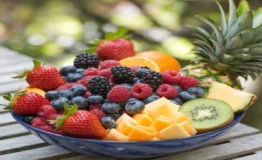Is Capellini the Same as Vermicelli?
Pasta varieties can sometimes be confusing, especially when two types appear similar. Capellini and vermicelli are examples of this confusion. Both types of pasta are thin, but they differ in ways that affect their uses in different dishes. This guide will help you understand these differences, making it easier to choose the right pasta for your meal.
What is Capellini?
Capellini, also known as angel hair in the United States, is one of the finest types of pasta. Its name translates to “little hairs” in Italian, which describes its thin and fragile strands.
- Origin: Capellini comes from Italy, where it has been part of the country’s cuisine for centuries. The thin strands are prevalent in regions known for light, simple pasta dishes.
- Typical Thickness: Capellini typically ranges from 0.85 mm to 0.92 mm in thickness. This thinness gives it a delicate texture and allows it to cook quickly.
- Common Uses: Capellini works best in light pasta dishes that require quick cooking and a delicate touch. It pairs well with light sauces, such as simple olive oil and garlic or fresh tomato-based sauces.
The Origins of Capellini
Capellini originated in the Abruzzo region of Italy, where delicate pasta has been a culinary tradition for centuries. Women in this region would hand-roll thin strands of pasta, and Capellini was considered a delicacy. Made from the finest durum wheat semolina, Capellini was often served on special occasions. Over time, it spread throughout Italy and became famous worldwide, especially in the United States.
Cooking Tips for Capellini
One of Capellini’s key features is its fast cooking time. Because of its thin nature, Capellini can cook in just 3 minutes, making it a perfect choice for quick meals. However, its delicate texture requires careful attention to avoid overcooking.
- Pro Tip: To cook Capellini perfectly, use a large pot of salted water at a rolling boil. Stir gently to prevent the strands from sticking together. Taste the pasta after 2-3 minutes to ensure it is al dente.
If you want to explore more about different Italian pasta shapes, check out this guide to Italian pasta shapes.
Popular Dishes Featuring Capellini
Capellini often appears in dishes that highlight fresh and simple ingredients. Here are some popular examples:
- Capellini Pomodoro: This dish showcases Capellini with a simple tomato sauce made from fresh tomatoes, garlic, and basil. The lightness of the pasta allows the sauce’s flavor to shine through.
- Capellini with Olive Oil and Garlic: This classic dish tosses Capellini with olive oil, garlic, and red pepper flakes for a quick, flavorful meal. The simplicity of the ingredients complements the delicate texture of the pasta.
- Capellini with Pesto: Capellini’s thin strands absorb pesto sauce, made from fresh basil, garlic, pine nuts, and Parmesan cheese. The result is a flavorful and aromatic dish that is both light and satisfying.
What is Vermicelli?
Vermicelli, like Capellini, is a thin pasta, but it varies in thickness and usage depending on the region. The word “vermicelli” means “little worms” in Italian, which refers to its appearance. While Italian vermicelli is traditionally thicker than Capellini, Asian vermicelli refers to much thinner noodles, often made from rice or mung bean starch.
- Origin: Vermicelli originated in Italy, where it is typically made from durum wheat. However, vermicelli has also become popular in Asian cuisine, where it is often made from rice or other starches.
- Typical Thickness: In Italy, vermicelli is thicker than Capellini, ranging from 1.5 mm to 2.08 mm in diameter. In Asia, vermicelli can be much thinner, similar to thin rice noodles.
- Common Uses: Vermicelli can be used in a variety of dishes, from soups and broths to stir-fries and salads. In Italian cuisine, vermicelli pairs well with heartier sauces, while in Asian cuisine, rice vermicelli is used in lighter dishes.
Global Versatility of Vermicelli
Vermicelli’s versatility across cultures makes it unique. In Italy, it is similar to spaghetti but slightly thinner, and it is often used in dishes that require a more substantial noodle than Capellini. In contrast, Asian vermicelli, especially rice vermicelli, plays a key role in dishes across Southeast Asia, China, and India.
- Italian Vermicelli: In Italy, vermicelli is often paired with more substantial sauces. It works well with seafood, tomato-based sauces, and meat-based ragùs.
- Asian Vermicelli: In Asia, vermicelli refers to skinny noodles made from rice or mung bean starch. These noodles are used in a variety of dishes, including Vietnamese vermicelli bowls (Bún), Chinese stir-fried vermicelli, and Indian vermicelli pudding (seviyan).
Cooking Tips for Vermicelli
Cooking vermicelli varies depending on the type of noodle. Italian vermicelli cooks in about 5-6 minutes, while rice vermicelli often requires soaking in hot water rather than boiling.
- Pro Tip: Stir Italian vermicelli occasionally to prevent clumping. For rice vermicelli, soak the noodles in hot water for 3-5 minutes until they soften. Then, drain and rinse them under cold water to stop the cooking process.
Want to know how to cook Asian vermicelli noodles? Check out this guide on cooking Asian vermicelli.
Popular Dishes Featuring Vermicelli
Vermicelli is a versatile pasta that can be used in a wide range of dishes. Here are some examples:
- Vermicelli with Seafood Sauce: This Italian dish pairs vermicelli with a rich seafood sauce made from tomatoes, garlic, and a variety of seafood like shrimp, clams, and mussels. The thicker strands of vermicelli hold up well to the sauce.
- Vermicelli Stir-Fry: In Asian cuisine, vermicelli is often stir-fried with vegetables, meats, and sauces. The thin rice noodles absorb the flavors of soy sauce, ginger, and garlic, creating a satisfying and flavorful dish.
- Vermicelli Noodle Salad: This refreshing salad features rice vermicelli tossed with fresh vegetables, herbs, and a tangy dressing. It’s popular in Vietnamese cuisine, where it’s often served with grilled meats or tofu.
Key Differences Between Capellini and Vermicelli
Though both Capellini and vermicelli are thin, their differences lie primarily in thickness, cooking time, and uses.
- Thickness: Capellini is thinner than vermicelli when comparing Italian versions.
- Cooking Time: Capellini cooks faster, usually within 3-4 minutes, while vermicelli takes about 5-6 minutes.
- Texture: Capellini’s delicate texture makes it ideal for light sauces, while vermicelli’s thicker strands hold up better in heartier sauces and soups.
- Global Variations: Italian vermicelli is thicker than Capellini, but Asian vermicelli is typically a thinner rice noodle used in entirely different culinary traditions.
Nutritional Differences
Capellini and vermicelli are both made from durum wheat semolina, rich in complex carbohydrates and a good source of energy. However, their nutritional profiles can vary based on thickness and regional variations.
- Caloric Content: A serving of Capellini typically contains around 200 calories. Vermicelli can range from 220 to 250 calories per serving, depending on thickness and ingredients.
- Carbohydrates and Protein: Both pasta types are high in carbohydrates, provide energy, and contain moderate amounts of protein. A typical serving of either contains about 40-45 grams of carbohydrates and 7-9 grams of protein.
- Asian Vermicelli: Rice vermicelli, commonly used in Asian dishes, is gluten-free, making it a suitable option for those with gluten sensitivities. However, it has slightly less protein compared to wheat-based vermicelli.
Visual Comparison: Capellini vs. Vermicelli
Here’s a simple comparison to visualize the differences:
- Capellini: Fine, delicate strands, almost hair-like in thinness. When cooked, Capellini becomes soft and tender, blending well with light sauces.
- Vermicelli: Thicker in its Italian form and more robust. It has more bite, making it perfect for hearty sauces and soups. Asian vermicelli, however, is much thinner, often resembling thin rice noodles that are ideal for stir-fries and salads.
Whether you’re preparing a quick pasta dish with Capellini or a flavorful Asian vermicelli stir-fry, understanding these visual and textural differences can help you choose the right pasta for your dish.
Culinary Uses of Capellini and Vermicelli in Italian Cuisine
Both Capellini and vermicelli have distinct uses in Italian cuisine. Each pasta brings its unique texture to the table.
- Capellini: Capellini often appears in light pasta dishes that focus on fresh ingredients. Some popular capellini dishes include:
- Capellini Pomodoro: Fresh tomatoes, garlic, olive oil, and basil make this simple yet flavorful dish. The delicate strands of Capellini soak up the light tomato sauce ideally.
- Capellini with Olive Oil and Garlic: This quick dish involves tossing Capellini with high-quality olive oil, garlic, and red pepper flakes.
- Vermicelli: Vermicelli’s thicker texture makes it a good match for more substantial sauces. Some popular vermicelli dishes include:
- Vermicelli with Seafood Sauce: This classic Italian dish uses a rich tomato and seafood sauce, often featuring shrimp, clams, or mussels.
- Vermicelli al Ragù: The thicker texture of vermicelli works well with meat-based sauces like ragù.
The versatility of these pasta types allows them to work well in dishes ranging from light and refreshing to rich and hearty.
Culinary Uses of Vermicelli in Asian Cuisine
Asian vermicelli differs significantly from its Italian counterpart. Typically made from rice or mung bean starch, these noodles play a key role in Southeast Asian and Chinese dishes. The lightness and versatility of rice vermicelli make it an ideal base for fresh, vibrant flavors.
- Vietnamese Vermicelli Bowls (Bún): These bowls combine rice vermicelli with fresh herbs, vegetables, grilled meats, and a tangy fish sauce dressing. The thin rice noodles offer a light, chewy base that complements bold flavors.
- Chinese Stir-Fried Vermicelli: In Chinese cuisine, vermicelli is often stir-fried with vegetables, meats, and sauces. The noodles absorb the savory flavors of soy sauce, ginger, and garlic, making a flavorful dish.
- Filipino Pancit: Pancit is a beloved Filipino dish featuring stir-fried vermicelli noodles mixed with vegetables, meats, and seasonings. Pancit is often served during celebrations, as it symbolizes long life and prosperity.
Asian vermicelli’s versatility makes it a popular ingredient in a wide range of dishes, from light salads to hearty stir-fries.
FAQs: Capellini vs. Vermicelli
- What is the main difference between Capellini and Vermicelli?
- Capellini is thinner and more delicate than vermicelli. Italian vermicelli is thicker, while Asian vermicelli refers to thin rice noodles.
- Can I substitute Capellini for vermicelli in recipes?
- Capellini works well in light dishes, but it may not hold up in heartier recipes. For Asian dishes, rice vermicelli is recommended because its texture differs from wheat-based Capellini.
- What are the best sauces for Capellini vs. vermicelli?
- Capellini pairs best with light, simple sauces like olive oil, garlic, and fresh herbs. Vermicelli, particularly the Italian variety, can handle robust sauces, such as seafood or tomato-based options.
- How do cooking times differ between Capellini and vermicelli?
- Capellini cooks faster, typically within 3-4 minutes. Vermicelli, depending on the variety, can take longer, around 5-6 minutes.
- Are capellini and vermicelli gluten-free?
- Traditional Capellini and Italian vermicelli are made from wheat, so they are not gluten-free. However, rice vermicelli used in Asian cuisine is gluten-free.
- Can vermicelli be used in soups?
- Yes, vermicelli, especially the Asian variety, is commonly used in soups like Pho or Chinese noodle soups. Italian vermicelli can also be used in brothy soups, though it’s more widely paired with sauces.
- What are some popular dishes that use Capellini?
- Capellini Pomodoro and Capellini with Olive Oil and Garlic are two popular dishes that highlight its delicate nature.
- What is the texture difference between Capellini and vermicelli?
- Capellini has a softer, more delicate texture, while vermicelli has more bite, especially in its Italian form.
- How does vermicelli differ between Italian and Asian cuisine?
- Italian vermicelli is thicker and made from wheat. Asian vermicelli is thinner and often made from rice or mung bean starch.
Conclusion
In conclusion, Capellini and vermicelli may seem similar, but they serve different culinary purposes depending on the dish and region. Capellini, being one of the thinnest pasta types, works best in light, delicate dishes. Vermicelli, on the other hand, offers versatility for heartier and more complex recipes, whether in its Italian or Asian form. Next time you prepare a meal, consider which of these two pasta types will best suit your needs, and don’t hesitate to experiment with both in your cooking.






